Analysis of LNG Storage Tank Safety: A Comprehensive Model Approach with ANP and Normal Cloud
Abstract
:1. Introduction
2. The Analytic Network Process
2.1. Establishing Indicators System
2.2. Calculation of Weights in ANP Model
2.3. Analysis of ANP Results
3. Normal Cloud Model
3.1. Overview of Normal Cloud Model
3.2. Risk Evaluation of LNG Leakage Accident Based on Normal Cloud Model
4. Analysis and Results
4.1. Risk Assessment Calculation
4.2. Method Contrast
B1 = [0.7802 0.0078 0.2121]
B2 = [0.1042 0.3629 0.3990 0.1339]
B3 = [0.1114 0.1808 0.4008 0.3070]
B4 = [0.1347 0.7188 0.1466]
B5 = [0.6527 0.1218 0.2256]
5. Discussion and Conclusions
- (1)
- As stated above, while ANP as a subjective weighting method can consider the correlation between risk elements, it increases the subjectivity of the results because different experts have different judgments on the relative importance of risk factors. The evaluation results obtained by different experts may be different [18]. An integrated weight calculation method should be considered in subsequent studies, which can combine ANP and other objective weighting methods.
- (2)
- Compared to the AHP, the computational process of ANP is more complex. The method is difficult to rely on manual work and more demanding on the experts invited. In some ways, the method is not as universal as AHP.
- (3)
- The normal cloud model conducts quantitative analysis based on the scores of professional institutions or experts on the safety degree of enterprises, and the model needs to be updated based on regular risk assessments, which cannot achieve real-time dynamic monitoring of tank safety.
Author Contributions
Funding
Institutional Review Board Statement
Informed Consent Statement
Data Availability Statement
Acknowledgments
Conflicts of Interest
References
- Zhou, S.W.; Zhu, J.L.; Shan, T.W.; Fu, Q.; Zhang, D.; Wang, J.P. Development Status and Outlook of Nature Gas and LNG Industry in China. China Offshore Oil Gas. 2022, 34, 1–8. [Google Scholar]
- Ren, Z.; Wang, D.Q.; Tong, Y.Z.; Liu, P. A Discussion on the Development of the LNG Industry Under the Dual Carbon Target. Shandong Chem. Ind. 2022, 51, 101–103. [Google Scholar]
- Li, H.Y.; Zhang, J.Q.; Chen, J.B.; Chen, W.H.; Zhao, Y.; Lin, M.Z.; Li, L.; Zhang, X.; Dai, X.D. Global energy transition faces challenges in 2021—Based on the bp Statistical Yearbook of World Energy (2022). Nat. Gas. Oil, 2022; in press. [Google Scholar]
- BP p.l.c. BP Statistical Review of World Energy. 2022. Available online: https://www.bp.com/en/global/corporate/energy-economics/statistical-review-of-world-energy.html (accessed on 20 November 2022).
- Ruszel, M. The Development of Global LNG Exports. In The Future of Energy Consumption, Security and Natural Gas; Liuhto, K., Ed.; Palgrave Macmillan: Cham, Switzerland, 2021; pp. 1–20. [Google Scholar]
- Kim, H.; Koh, J.-S.; Kim, Y.; Theofanous, T.G. Risk assessment of membrane type LNG storage tanks in Korea-based on fault tree analysis. Korean J. Chem. Eng. 2005, 22, 1–8. [Google Scholar] [CrossRef]
- Oka, H.; Ota, S. Evaluation of consequence assessment methods for pool fires on water involving large spills from liquefied natural gas carriers. J. Mar. Sci. Technol. 2008, 13, 178–188. [Google Scholar] [CrossRef]
- Koyama, K. CFD Simulation on LNG Storage Tank to Improve Safety and Reduce Cost. In Systems Modeling and Simulation; Koyamada, K., Tamura, S., Ono, O., Eds.; Springer: Tokyo, Japan, 2007; pp. 39–43. [Google Scholar]
- Ma, X.; Shi, T.H.; Xue, T.; Xu, Y.Y. Improvement of accident tree analysis of LNG tank leakage with Bayesian Networks. Mod. Chem. Ind. 2017, 37, 179–182. [Google Scholar]
- Yang, L.P.; Du, S.N.; Wang, W.Q.; Wang, B.; Geng, X.H. Dynamic risk analysis of continuous leakage of LNG storage tank. Chem. Eng. Oil Gas. 2020, 49, 109–116+122. [Google Scholar]
- Yucelgazi, F.; Yitmen, İ. An ANP Model for Risk Assessment in Large-Scale Transport Infrastructure Projects. Arab. J. Sci. Eng. 2019, 44, 4257–4275. [Google Scholar] [CrossRef]
- Cil, I.; Turkan, Y.S. An ANP-based assessment model for lean enterprise transformation. Int. J. Adv. Manuf. Technol. 2013, 64, 1113–1130. [Google Scholar] [CrossRef]
- Zhao, P.Y.; Guo, X.Q.; Xu, D.C.; Yao, X. Evaluation of rescue capability of mine rescue team based on network analytic hierarchy method. China Coal 2019, 45, 66–70. [Google Scholar]
- Razavi Toosi, S.L.; Samani, J.M.V. A New Integrated MADM Technique Combined with ANP, FTOPSIS and Fuzzy Max-Min Set Method for Evaluating Water Transfer Projects. Water Resour. Manag. 2014, 28, 4257–4272. [Google Scholar] [CrossRef]
- Gu, Q.W.; Zhang, L.; Zhao, X.H.; Wang, H.S.; Dong, Y. Evaluation of regional water environment carrying capacity based on ANP-Normal cloud model. J. China Inst. Water Resour. Hydropower Res. 2021, 19, 506–515. [Google Scholar]
- Purwosaputra, A.A.; Artana, K.B.; Dinariyana, A.A.B. Selection over small-scale LNG transportation model in designing an efficient and reliable LNG supply chain using analytical network process. Mar. Syst Ocean. Technol. 2022, 17, 95–112. [Google Scholar] [CrossRef]
- Saaty, T.L.; Vargas, L.G. Decision Making with the Analytic Network Process; International Series in Operations Research & Management Science; Springer: Boston, MA, USA, 2013; Volume 195, pp. 1–40. [Google Scholar]
- Gan, L.; Hu, Y.; Zheng, L.Z.; Hu, S.H. Comprehensive evaluation on capability of electric power emergency rescue team based on improved ANP-TOPSIS. J. Saf. Sci. Technol. 2022; in press. [Google Scholar]
- Sun, H.C.; Tian, P. The Analytic Network Process and Science Decision. In Proceedings of the 12th Annual Conference of the Chinese Society of Systems Engineering, China, October 2002. [Google Scholar]
- Fan, Z.P.; Zhang, J.J.; Wen, W.; Li, C.P.; Jing, Y.P. Design and Implementation of ANP Analysis Tool Based on Analytic Network Process. Comput. Digit. Eng. 2020, 48, 46–50. [Google Scholar]
- Xu, K.; Chen, X.F. ”High Five” Risk Management System Based on Major Accidents Prevention. J. Wuhan Univ. Technol. (Inf. Manag. Eng.) 2017, 39, 649–653. [Google Scholar]
- Li, W.; Ye, Y.C.; Wang, Q.H.; Wang, X.H.; Hu, N.Y. Risk identification and assessment model for high risk factors of accidents of cage crashing in mine. J. Catastrophol. 2020, 35, 64–70. [Google Scholar]
- Wudhikarn, R. Improving the intellectual capital management approach using the hybrid decision method. J. Intellect. Cap. 2018, 19, 670–691. [Google Scholar] [CrossRef]
- Zha, S.S.; Guo, Y.; Huang, S.H.; Tang, P.Z. A hybrid MCDM approach based on ANP and TOPSIS for facility layout selection. Trans. Nanjing Univ. Aero. Astro 2018, 35, 1027–1037. [Google Scholar]
- Wudhikarn, R.; Chakpitak, N.; Neubert, G. Improving the Strategic Benchmarking of Intellectual Capital Management in Logistics Service Providers. Sustainability 2020, 12, 10174. [Google Scholar] [CrossRef]
- Wang, L.F. The Theory and Algorithm of Analytic Network Process. Syst. Eng.-Theory Pract. 2001, 3, 44–50. [Google Scholar]
- Li, Y.D.; Liu, C.Y. Study on the Universality of the Normal Cloud Model. Strateg. Study CAE 2004, 8, 28–34. [Google Scholar]
- Zhang, S.B.; Xu, C.X. Study on the Trust Evaluation Approach Based on Cloud Model. Chin. J. Comput. 2013, 36, 422–431. [Google Scholar] [CrossRef]
- Chen, L.; Jin, L.; Huang, B.; Cao, W.D.; Wang, X.D. On the quantitative Bow-tie analysis of the tank leakage risk based on the 2-D cloud model. J. Saf. Environ. 2020, 20, 809–815. [Google Scholar]
- Jing, M.B.; Li, X.H. Study on the construction of a safety production risk grading and control system for LNG receiving stations. China Pet. Chem. Stand. Qual. 2021, 41, 5–6. [Google Scholar]
- Huang, W.Y. Risk Assessment and Countermeasure Research of LNG Ship Navigate in Dapeng Bay Based on Entropy-Cloud Model. Master’s Thesis, Dalian Maritime University, Dalian, China, 2019. [Google Scholar]
- Li, W.D.; Zhou, D.H.; Xiao, Z.H.; Zhang, M. Risk Analysis of LNG Storage Tank Based on Bow-tie—Normal Cloud Model. Fire Sci. Technol. 2021, 40, 1322–1327. [Google Scholar]
- Qiang, X.H.; Ma, J.J. Evaluation of Urban Transit Service Level Based on ANP and Cloud Model. Traffic Transp. 2022, 38, 27–32. [Google Scholar]
- Zhu, G.H.; Sun, X.W. Security Risk Evaluation of Warship Training Activities Using ANP-Cloud Model. Command Control Simul. 2022; in press. [Google Scholar]
- Xiao, Z.H.; Zhou, D.H.; Li, W.D.; Chang, L.; Wang, N.; Liu, Y.; Dai, T.W. Safety Risk Assessment of Chemical Industry Park Based on Cloud Model. J. Wuhan Inst. Technol. 2022, 44, 112–118. [Google Scholar]
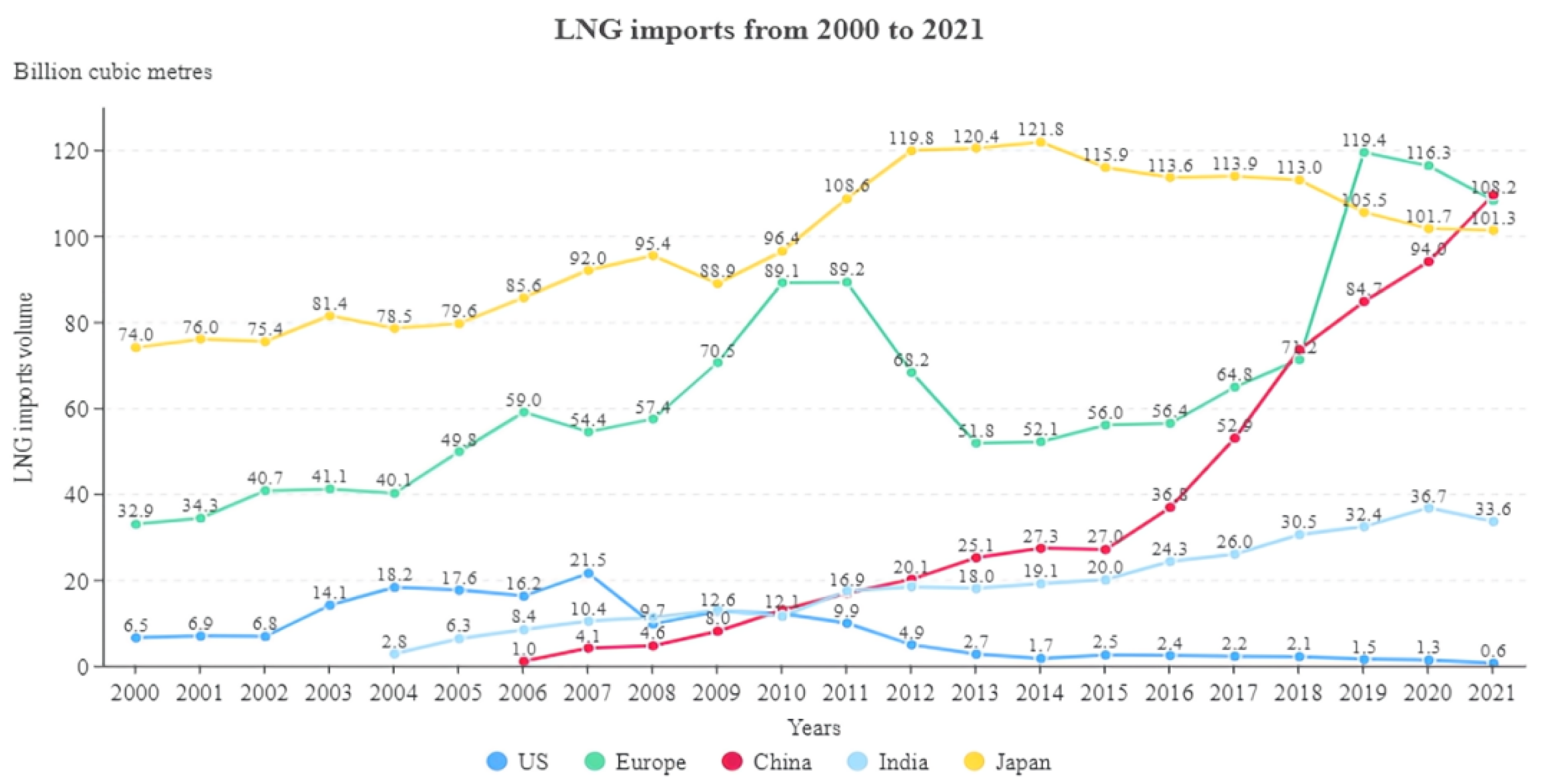
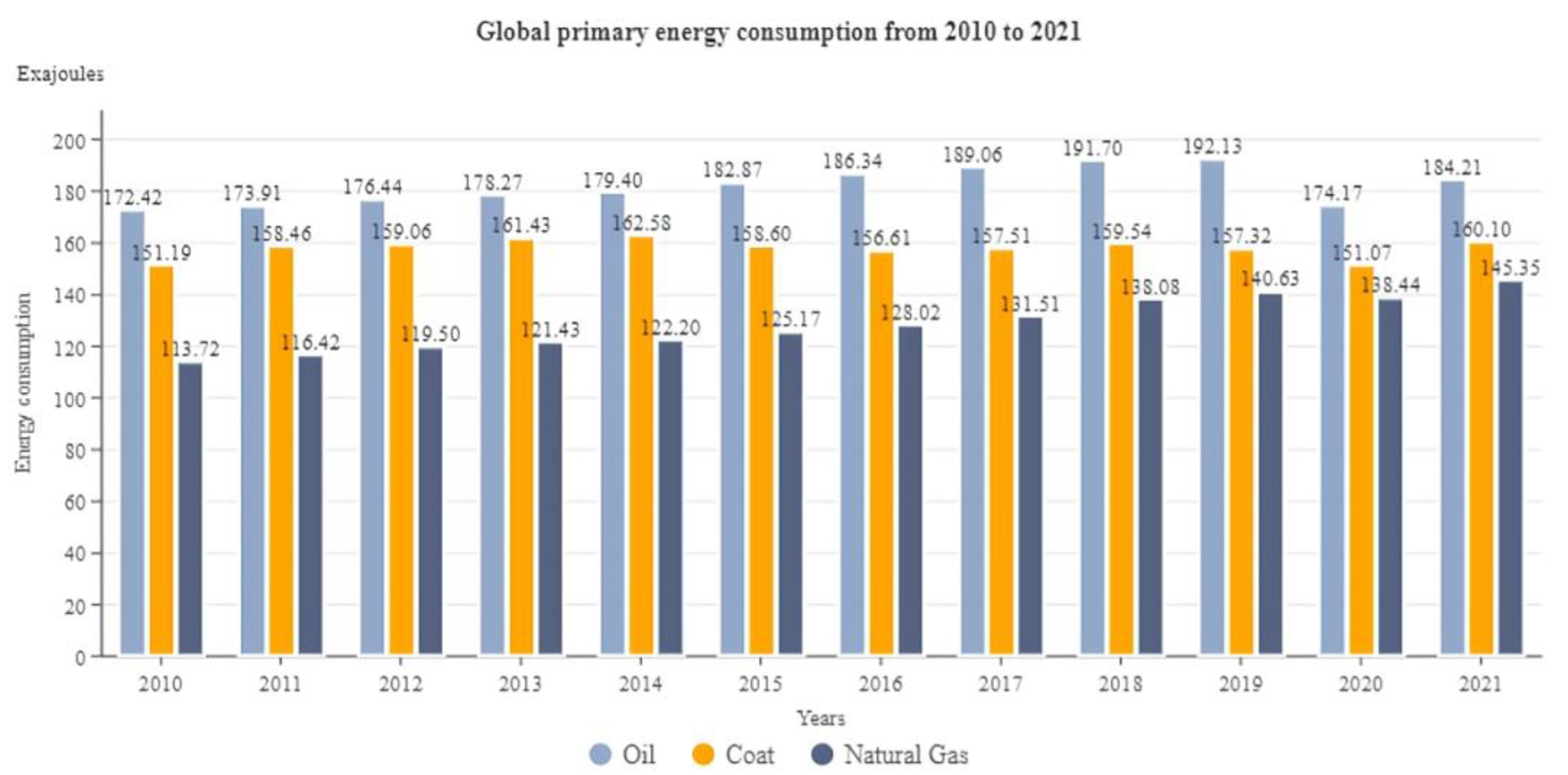
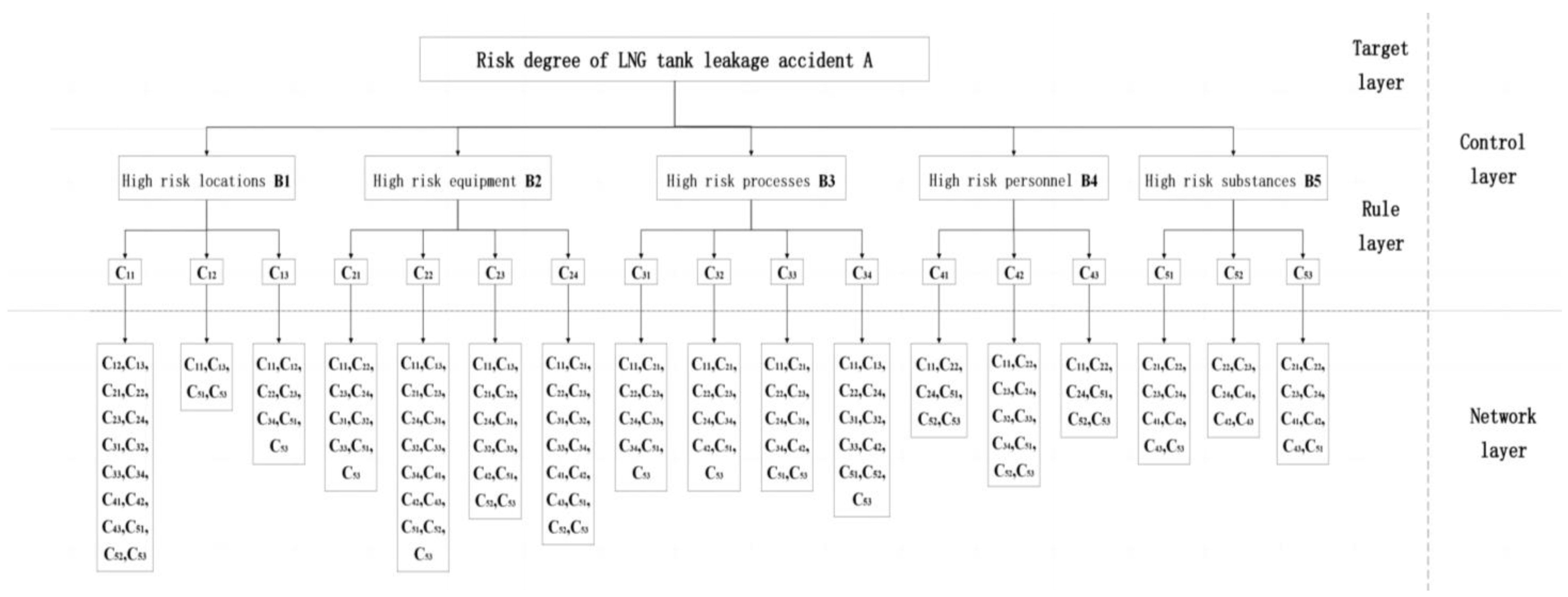

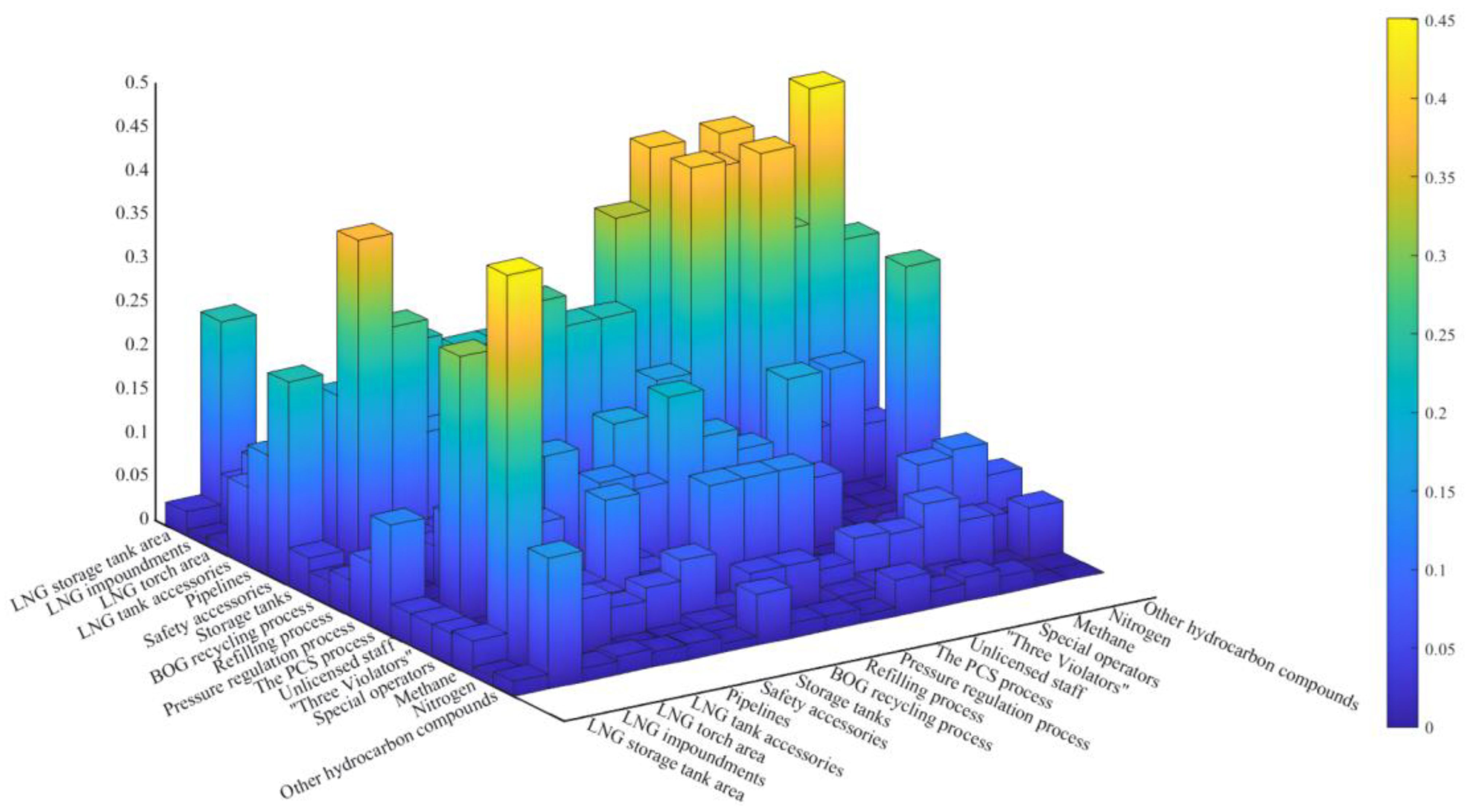
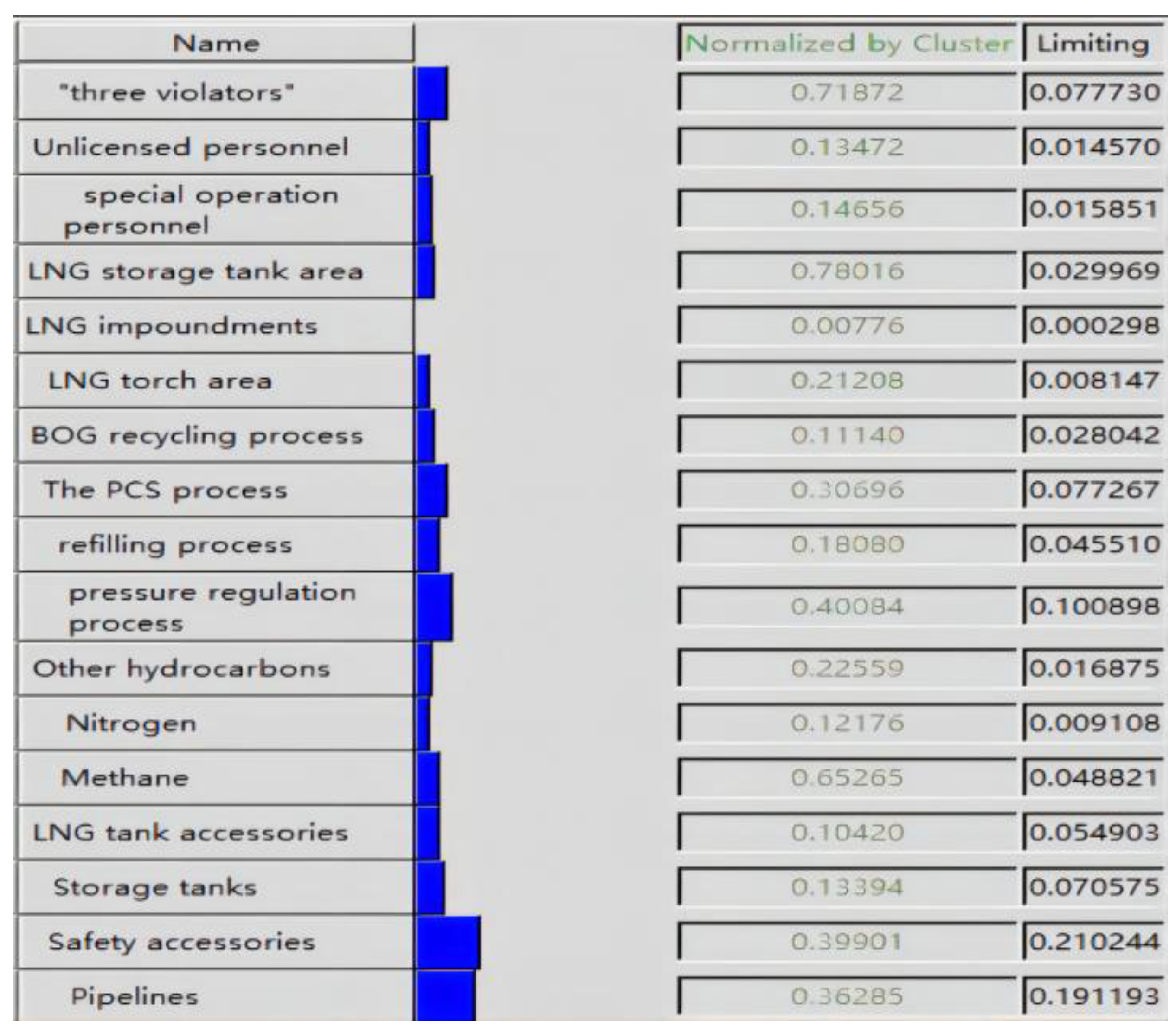

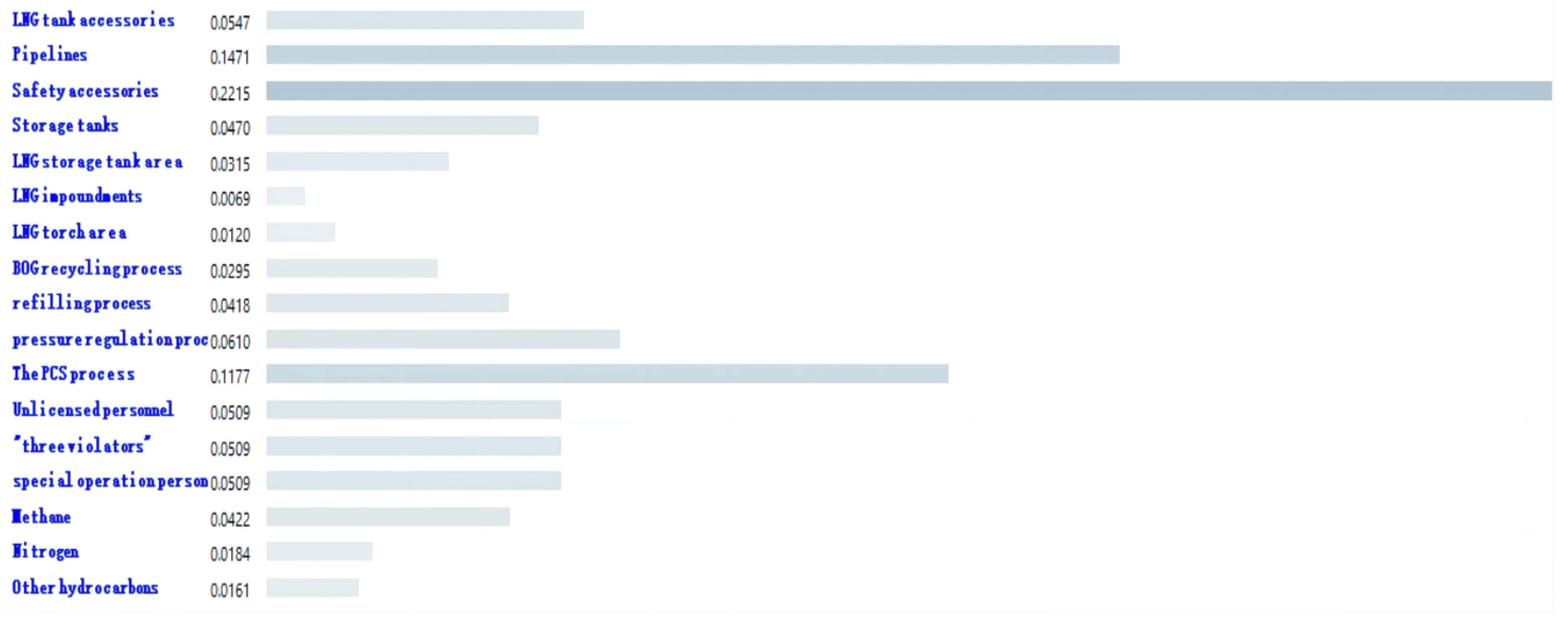
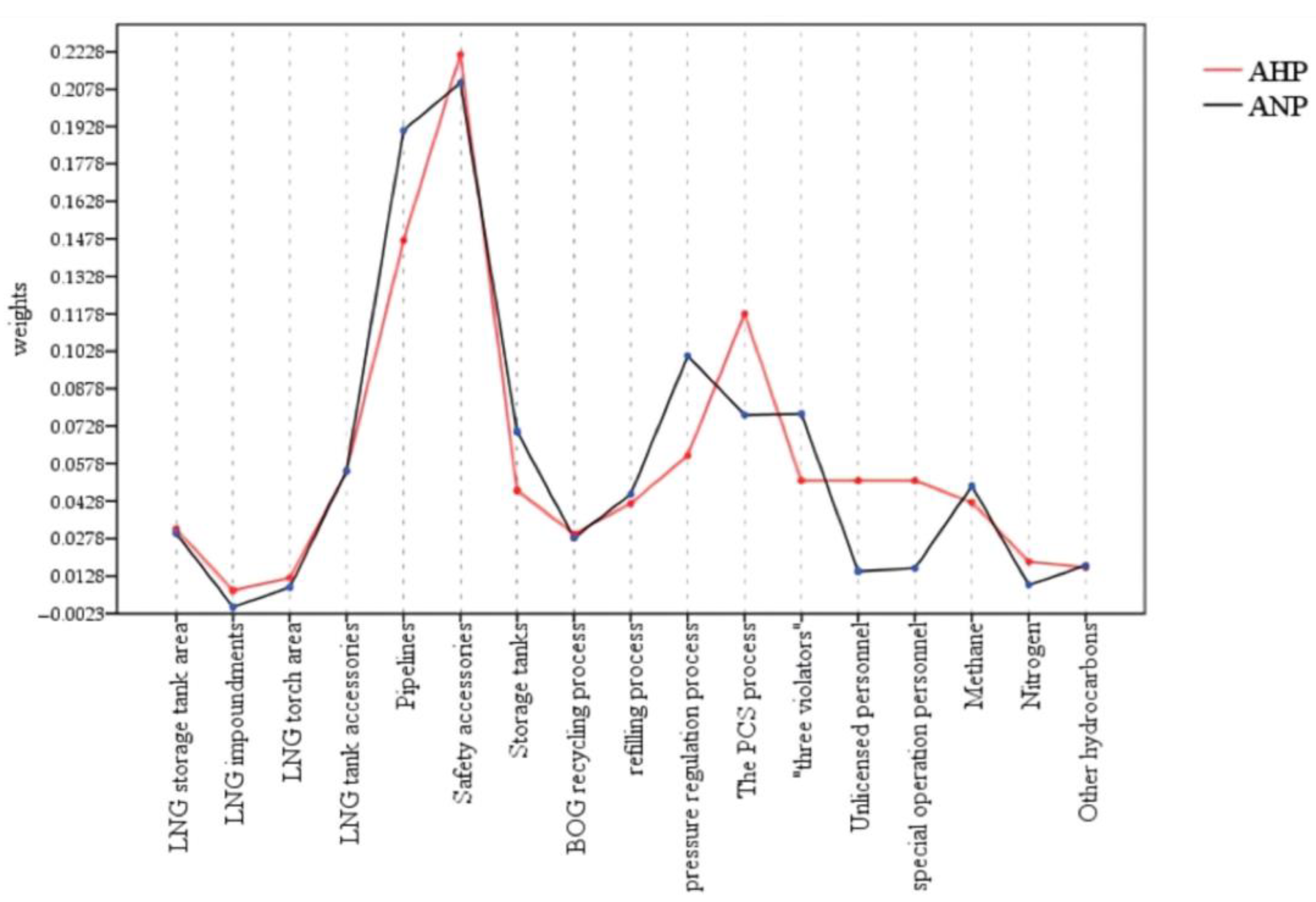

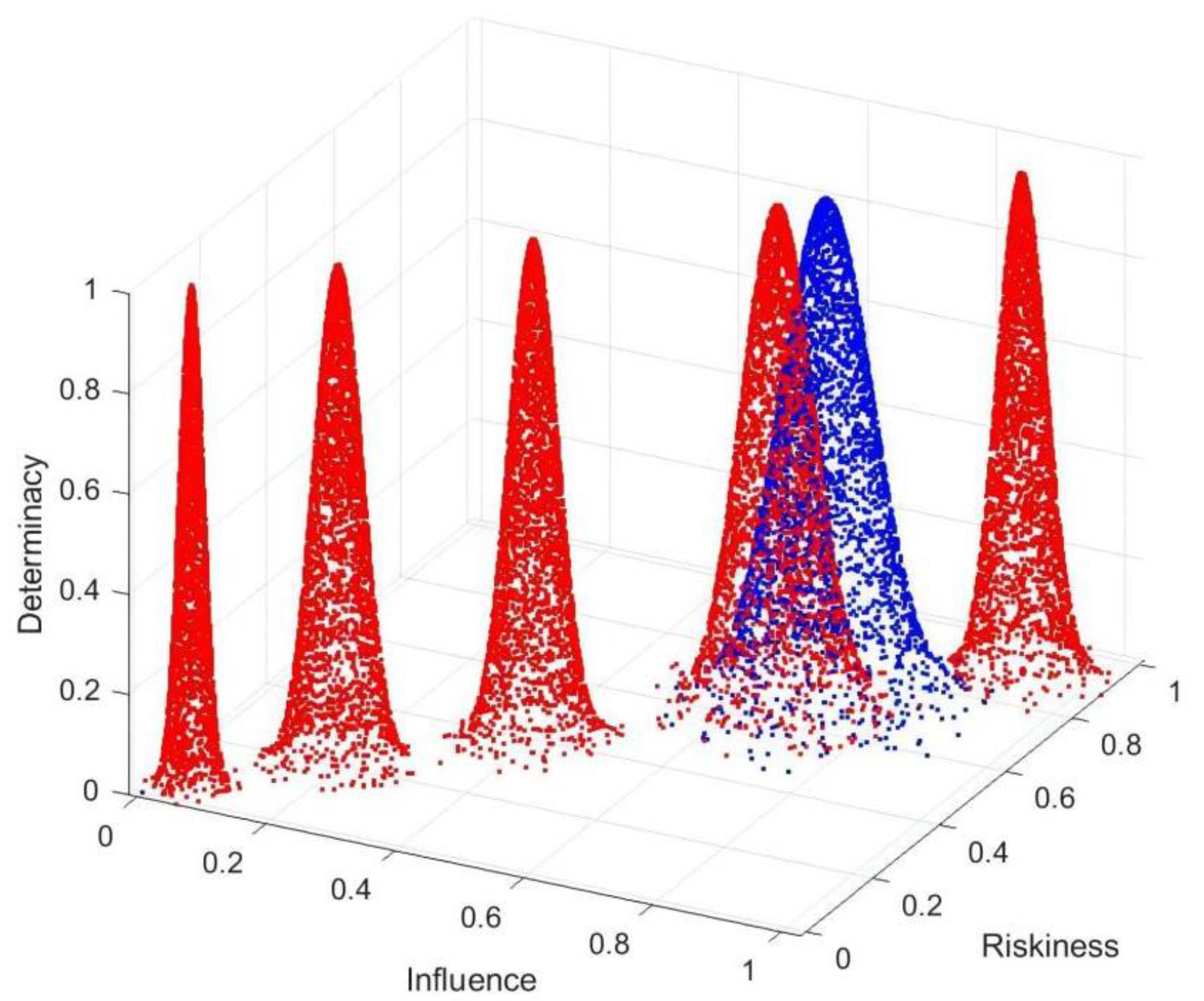
| First-Level Elements | Description | Second-Level Elements | Description |
|---|---|---|---|
| High-risk locations B1 | Places where an accident could lead to serious consequences. | LNG storage tank area C11 | The LNG storage area is a place where LNG is stored centrally. The likelihood of accidents is greater, and the consequences are more serious than in other areas. |
| LNG impoundments C12 | Cofferdams installed in LNG storage tank areas to intercept and recover leaking LNG | ||
| LNG torch area C13 | Handling of Boil-Off Gas (BOG) gas that cannot be effectively recovered in the event of a leak, preventing more serious accidents | ||
| High-risk equipment B2 | Equipment and facilities which failure or loss of control during operation could lead to a serious accident. | LNG tank accessories C21 | Accessories for LNG storage tanks |
| Pipelines C22 | Pipelines connected to LNG storage tanks | ||
| Safety accessories C23 | Safety accessories on LNG storage tanks and pipelines, including valves, flanges, and other accessories. | ||
| Storage tanks C24 | LNG storage tanks, which can cause serious consequences and losses once the tank body breaks and causes leakage accident. | ||
| High-risk processes B3 | Processes where loss of control of the process could lead to a serious accident. | Boil-Off Gas (BOG) recycling process C31 | Process for condensing or compressing BOG inside LNG storage tanks for recovery. |
| Refilling processC32 | Process for the auxiliary transfer of LNG with cryogenic submersible pumps. | ||
| Pressure regulation processC33 | Process to control the pressure inside LNG storage tanks to prevent overpressure or negative pressure in the tanks. | ||
| The Process Control System (PCS) process C34 | PCS is a system that can centralize monitoring and management for main devices and supporting facilities. | ||
| High-risk personnel B4 | Persons prone to accidents in the course of operation. | Unlicensed personnel C41 | Operators without relevant qualification or the one whose qualification has not been reviewed beyond the validity. |
| “Three violators” C42 | Operators who “command violation” “work in violation of regulations” or “violation of labor discipline”. | ||
| Special operation personnelC43 | Operators engaged in special types of work in LNG storage areas. | ||
| High-risk substances B5 | Hazardous substances present in LNG that could lead to a serious accident. | Methane C51 | The main component of LNG, which is flammable and explosive. |
| Nitrogen C52 | High concentrations of nitrogen can lead to asphyxiation and even death of the operator. | ||
| Other hydrocarbons C54 | Hydrocarbons with flammable and explosive properties, the mixing of which with air will produce an explosive mixture. |
| Name | Age Group | Title | Working Years | Certificates |
|---|---|---|---|---|
| Expert 1 | 30–40 | Intermediate Engineer | 5 | Intermediate Certified Safety Engineer |
| Expert 2 | 40–45 | Intermediate Engineer | 8 | Intermediate Certified Safety Engineer; Safety evaluation engineer |
| Expert 3 | 45–50 | Deputy Senior Engineer | 15 | Intermediate Certified Safety Engineer |
| Expert 4 | 50–55 | Deputy Senior Engineer | 13 | Intermediate Certified Safety Engineer; Safety evaluation engineer |
| Expert 5 | 55–65 | Senior Engineer | 22 | Intermediate Certified Safety Engineer; Safety evaluation engineer |
| High-Risk Locations | High-Risk Locations | High-Risk Equipment | High-Risk Processes | High-Risk Personnel | High-Risk Substances | Eigenvector |
|---|---|---|---|---|---|---|
| High-risk locations | 1 | 1/7 | 1/6 | 1/3 | 1/2 | 0.045408 |
| High-risk equipment | 7 | 1 | 3 | 5 | 6 | 0.504829 |
| High-risk processes | 6 | 1/3 | 1 | 3 | 5 | 0.269431 |
| High-risk personnel | 3 | 1/5 | 1/3 | 1 | 2 | 0.111767 |
| High-risk substances | 2 | 1/6 | 1/5 | 1/2 | 1 | 0.068565 |
| Consistency ratio (CR) = 0.0341 < 0.1 | ||||||
| Cluster Node Labels | High-Risk Locations | High-Risk Equipment | High-Risk Processes | High-Risk Personnel | High-Risk Substances |
|---|---|---|---|---|---|
| High-risk locations | 0.045408 | 0.038110 | 0.039359 | 0.049895 | 0.000000 |
| High-risk equipment | 0.504829 | 0.486508 | 0.488811 | 0.559624 | 0.555388 |
| high-risk processes | 0.269431 | 0.267231 | 0.275532 | 0.296611 | 0.266138 |
| high-risk personnel | 0.111767 | 0.136513 | 0.128681 | 0.000000 | 0.119541 |
| high-risk substances | 0.068565 | 0.071638 | 0.067616 | 0.093870 | 0.058933 |
| High-Risk Locations | High-Risk Equipment | High-Risk Processes | High-Risk Personnel | High-Risk Substances | |||||||||||||
|---|---|---|---|---|---|---|---|---|---|---|---|---|---|---|---|---|---|
| C11 | C12 | C13 | C21 | C22 | C23 | C24 | C31 | C32 | C33 | C34 | C41 | C42 | C43 | C51 | C52 | C53 | |
| High-risk locations | |||||||||||||||||
| C11 | 0.029969 | 0.02997 | 0.029969 | 0.02997 | 0.029969 | 0.02997 | 0.029969 | 0.02997 | 0.029969 | 0.02997 | 0.029969 | 0.02997 | 0.029969 | 0.02997 | 0.029969 | 0.02997 | 0.029969 |
| C12 | 0.000298 | 0.00030 | 0.000298 | 0.00030 | 0.000298 | 0.00030 | 0.000298 | 0.00030 | 0.000298 | 0.00030 | 0.000298 | 0.00030 | 0.000298 | 0.00030 | 0.000298 | 0.00030 | 0.000298 |
| C13 | 0.008147 | 0.00815 | 0.008147 | 0.00815 | 0.008147 | 0.00815 | 0.008147 | 0.00815 | 0.008147 | 0.00815 | 0.008147 | 0.00815 | 0.008147 | 0.00815 | 0.008147 | 0.00815 | 0.008147 |
| High-risk equipment | |||||||||||||||||
| C21 | 0.054903 | 0.05490 | 0.054903 | 0.05490 | 0.054903 | 0.05490 | 0.054903 | 0.05490 | 0.054903 | 0.05490 | 0.054903 | 0.05490 | 0.054903 | 0.05490 | 0.054903 | 0.05490 | 0.054903 |
| C22 | 0.191193 | 0.19119 | 0.191193 | 0.19119 | 0.191193 | 0.19119 | 0.191193 | 0.19119 | 0.191193 | 0.19119 | 0.191193 | 0.19119 | 0.191193 | 0.19119 | 0.191193 | 0.19119 | 0.191193 |
| C23 | 0.210244 | 0.21024 | 0.210244 | 0.21024 | 0.210244 | 0.21024 | 0.210244 | 0.21024 | 0.210244 | 0.21024 | 0.210244 | 0.21024 | 0.210244 | 0.21024 | 0.210244 | 0.21024 | 0.210244 |
| C24 | 0.070575 | 0.07058 | 0.070575 | 0.07058 | 0.070575 | 0.07058 | 0.070575 | 0.07058 | 0.070575 | 0.07058 | 0.070575 | 0.07058 | 0.070575 | 0.07058 | 0.070575 | 0.07058 | 0.070575 |
| High-risk processes | |||||||||||||||||
| C31 | 0.028042 | 0.02804 | 0.028042 | 0.02804 | 0.028042 | 0.02804 | 0.028042 | 0.02804 | 0.028042 | 0.02804 | 0.028042 | 0.02804 | 0.028042 | 0.02804 | 0.028042 | 0.02804 | 0.028042 |
| C32 | 0.045510 | 0.04551 | 0.045510 | 0.04551 | 0.045510 | 0.04551 | 0.045510 | 0.04551 | 0.045510 | 0.04551 | 0.045510 | 0.04551 | 0.045510 | 0.04551 | 0.045510 | 0.04551 | 0.045510 |
| C33 | 0.100898 | 0.10090 | 0.100898 | 0.10090 | 0.100898 | 0.10090 | 0.100898 | 0.10090 | 0.100898 | 0.10090 | 0.100898 | 0.10090 | 0.100898 | 0.10090 | 0.100898 | 0.10090 | 0.100898 |
| C34 | 0.077267 | 0.07727 | 0.077267 | 0.07727 | 0.077267 | 0.07727 | 0.077267 | 0.07727 | 0.077267 | 0.07727 | 0.077267 | 0.07727 | 0.077267 | 0.07727 | 0.077267 | 0.07727 | 0.077267 |
| High-risk personnel | |||||||||||||||||
| C41 | 0.014570 | 0.01457 | 0.014570 | 0.01457 | 0.014570 | 0.01457 | 0.014570 | 0.01457 | 0.014570 | 0.01457 | 0.014570 | 0.01457 | 0.014570 | 0.01457 | 0.014570 | 0.01457 | 0.014570 |
| C42 | 0.077730 | 0.07773 | 0.077730 | 0.07773 | 0.077730 | 0.07773 | 0.077730 | 0.07773 | 0.077730 | 0.07773 | 0.077730 | 0.07773 | 0.077730 | 0.07773 | 0.077730 | 0.07773 | 0.077730 |
| C43 | 0.015851 | 0.01585 | 0.015851 | 0.01585 | 0.015851 | 0.01585 | 0.015851 | 0.01585 | 0.015851 | 0.01585 | 0.015851 | 0.01585 | 0.015851 | 0.01585 | 0.015851 | 0.01585 | 0.015851 |
| High-risk substances | |||||||||||||||||
| C51 | 0.048821 | 0.04882 | 0.048821 | 0.04882 | 0.048821 | 0.04882 | 0.048821 | 0.04882 | 0.048821 | 0.04882 | 0.048821 | 0.04882 | 0.048821 | 0.04882 | 0.048821 | 0.04882 | 0.048821 |
| C52 | 0.009108 | 0.00911 | 0.009108 | 0.00911 | 0.009108 | 0.00911 | 0.009108 | 0.00911 | 0.009108 | 0.00911 | 0.009108 | 0.00911 | 0.009108 | 0.00911 | 0.009108 | 0.00911 | 0.009108 |
| C53 | 0.016875 | 0.01688 | 0.016875 | 0.01688 | 0.016875 | 0.01688 | 0.016875 | 0.01688 | 0.016875 | 0.01688 | 0.016875 | 0.01688 | 0.016875 | 0.01688 | 0.016875 | 0.01688 | 0.016875 |
| Risk Level | Degree of Risk | Risk Description | Numerical Characteristics of Cloud Model (Ex, En, He) | Risk-Level Threshold |
|---|---|---|---|---|
| I | Low risk | Low probability of an accident; low consequence of an accident; negligible level of risk | (0.05, 0.0167, 0.01) | [0, 0.1) |
| II | General risk | May cause minor accidents; not serious consequences; low level of risk | (0.2, 0.0334, 0.01) | [0.1, 0.3) |
| III | Medium risk | Low probability of causing an accident; relatively serious consequences of an accident; risk within acceptable limits | (0.4, 0.0334, 0.01) | [0.3, 0.5) |
| IV | High risk | High likelihood of causing an accident; Relatively serious consequences of accidents; high level of risk; Measures to be taken if necessary and regular monitoring | (0.65, 0.0501, 0.01) | [0.5, 0.8) |
| V | Significant risk | High potential for accidents; serious consequences in the event of an accident; requires immediate stoppage for rectification and inspection to reduce risk | (0.9, 0.0334, 0.01) | [0.8, 1.0] |
| High-Risk Equipment | Expert 1 | Expert 2 | Expert 3 | Expert 4 | Expert 5 | Numerical Characteristics | Weights ω |
|---|---|---|---|---|---|---|---|
| LNG tank accessories C21 | 0.5 | 0.7 | 0.6 | 0.8 | 0.7 | (0.6600, 0.1103, 0.0289) | 0.1024 |
| Pipelines C22 | 0.6 | 0.8 | 0.7 | 0.9 | 0.7 | (0.7400, 0.1103, 0.0289) | 0.3629 |
| Safety accessories C23 | 0.8 | 0.9 | 0.9 | 0.7 | 0.8 | (0.8200, 0.0802, 0.0238) | 0.3990 |
| Storage tanks C24 | 0.5 | 0.7 | 0.8 | 0.6 | 0.7 | (0.6600, 0.1103, 0.0289) | 0.1339 |
| Risk level of High-risk equipment | (0.7517, 0.0993, 0.0268) | ||||||
| Second-Level Elements | Numerical Characteristics | Second-Level Weight | Comprehensive Weight ω | Risk Level |
|---|---|---|---|---|
| LNG storage tank area C11 | (0.3600, 0.1103, 0.0289) | 0.7802 | 0.0299 | III |
| LNG impoundments C12 | (0.3600, 0.1103, 0.0289) | 0.0078 | 0.0003 | III |
| LNG torch area C13 | (0.4400, 0.0602, 0.0249) | 0.2121 | 0.0082 | III |
| LNG tank accessories C21 | (0.6600, 0.1103, 0.0289) | 0.1042 | 0.0549 | IV |
| Pipelines C22 | (0.7400, 0.1103, 0.0289) | 0.3629 | 0.1912 | IV |
| Safety accessories C23 | (0.8200, 0.0802, 0.0238) | 0.3990 | 0.2102 | V |
| Storage tanks C24 | (0.6600, 0.1103, 0.0289) | 0.1339 | 0.0706 | IV |
| BOG recycling process C31 | (0.6600, 0.0902, 0.0120) | 0.1114 | 0.028 | IV |
| Refilling processC32 | (0.7000, 0.0501, 0.0499) | 0.1808 | 0.0455 | IV |
| Pressure regulation processC33 | (0.7200, 0.0802, 0.0238) | 0.4008 | 0.1009 | IV |
| The PCS process C34 | (0.6800, 0.0802, 0.0238) | 0.3070 | 0.0773 | IV |
| Unlicensed personnel C41 | (0.7000, 0.0501, 0.0499) | 0.1347 | 0.0146 | IV |
| “Three violators” C42 | (0.7200, 0.0802, 0.0238) | 0.7188 | 0.0777 | IV |
| Special operation personnelC43 | (0.6800, 0.0401, 0.0198) | 0.1466 | 0.0158 | IV |
| Methane C51 | (0.4600, 0.0602, 0.0249) | 0.6527 | 0.0488 | III |
| Nitrogen C52 | (0.3600, 0.0902, 0.0120) | 0.1218 | 0.0091 | III |
| Other hydrocarbons C54 | (0.3600, 0.1103, 0.0289) | 0.2256 | 0.0169 | III |
| First-Level Elements | Numerical Characteristics | Comprehensive Weights ω | Risk Level |
|---|---|---|---|
| High-risk locations B1 | (0.3770, 0.1018, 0.0281) | 0.038 | III |
| High-risk equipment B2 | (0.7517, 0.0993, 0.0268) | 0.529 | IV |
| High-risk processes B3 | (0.6974, 0.0769, 0.0272) | 0.251 | IV |
| High-risk personnel B4 | (0.7115, 0.0721, 0.0267) | 0.122 | IV |
| High-risk substances B5 | (0.4253, 0.0781, 0.0242) | 0.075 | III |
| LNG storage tank leakage accident A | (0.7057, 0.0905, 0.0271) | IV |
| Evaluation Indicators | Normal Cloud Model | Risk Level 1 | Fuzzy Comprehensive Evaluation | Risk Level 2 | Comprehensive Weight ω |
|---|---|---|---|---|---|
| High-risk locations | 0.3770 | III | 0.4291 | III | 0.038 |
| High-risk equipment | 0.7517 | IV | 0.7767 | IV | 0.529 |
| High-risk processes | 0.6974 | IV | 0.7207 | IV | 0.251 |
| High-risk personnel | 0.7115 | IV | 0.7580 | IV | 0.122 |
| High-risk substances | 0.4253 | III | 0.5043 | III | 0.075 |
Publisher’s Note: MDPI stays neutral with regard to jurisdictional claims in published maps and institutional affiliations. |
© 2022 by the authors. Licensee MDPI, Basel, Switzerland. This article is an open access article distributed under the terms and conditions of the Creative Commons Attribution (CC BY) license (https://creativecommons.org/licenses/by/4.0/).
Share and Cite
Peng, S.; Zhou, D.; Xie, B. Analysis of LNG Storage Tank Safety: A Comprehensive Model Approach with ANP and Normal Cloud. Appl. Sci. 2022, 12, 11941. https://doi.org/10.3390/app122311941
Peng S, Zhou D, Xie B. Analysis of LNG Storage Tank Safety: A Comprehensive Model Approach with ANP and Normal Cloud. Applied Sciences. 2022; 12(23):11941. https://doi.org/10.3390/app122311941
Chicago/Turabian StylePeng, Shiyu, Dehong Zhou, and Bin Xie. 2022. "Analysis of LNG Storage Tank Safety: A Comprehensive Model Approach with ANP and Normal Cloud" Applied Sciences 12, no. 23: 11941. https://doi.org/10.3390/app122311941
APA StylePeng, S., Zhou, D., & Xie, B. (2022). Analysis of LNG Storage Tank Safety: A Comprehensive Model Approach with ANP and Normal Cloud. Applied Sciences, 12(23), 11941. https://doi.org/10.3390/app122311941






